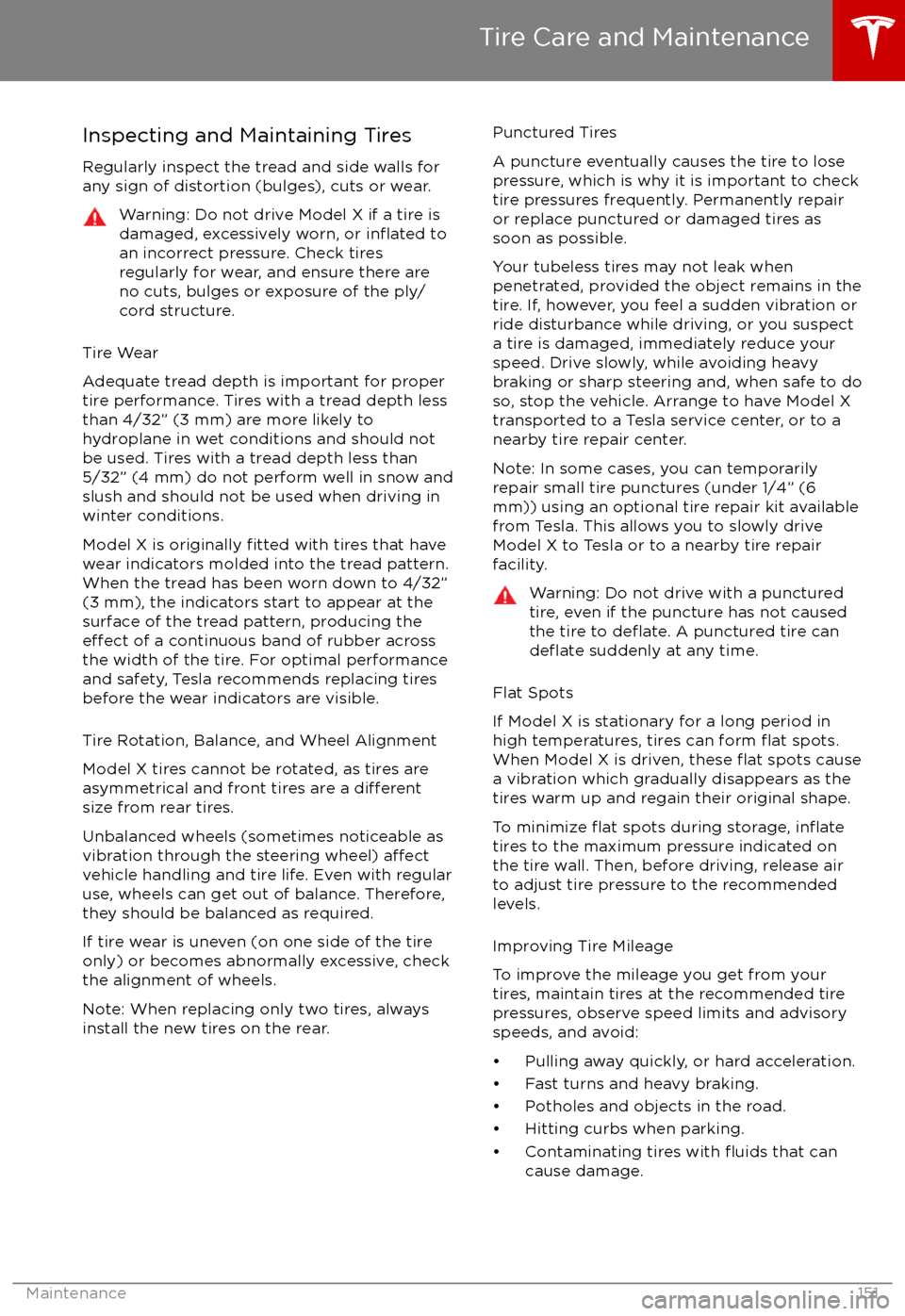Page 152 of 198

Inspecting and Maintaining TiresRegularly inspect the tread and side walls for
any sign of distortion (bulges), cuts or wear.Warning: Do not drive Model X if a tire is
damaged, excessively worn, or inflated to
an incorrect pressure. Check tires
regularly for wear, and ensure there are
no cuts, bulges or exposure of the ply/
cord structure.
Tire Wear
Adequate tread depth is important for proper
tire performance. Tires with a tread depth less
than 4/32” (3 mm) are more likely to
hydroplane in wet conditions and should not
be used. Tires with a tread depth less than
5/32” (4 mm) do not perform well in snow and
slush and should not be used when driving in
winter conditions.
Model X is originally
fitted with tires that have
wear indicators molded into the tread pattern. When the tread has been worn down to 4/32”(3 mm), the indicators start to appear at thesurface of the tread pattern, producing the
effect of a continuous band of rubber across
the width of the tire. For optimal performance
and safety, Tesla recommends replacing tires
before the wear indicators are visible.
Tire Rotation, Balance, and Wheel Alignment
Model X tires cannot be rotated, as tires are
asymmetrical and front tires are a
differentsize from rear tires.
Unbalanced wheels (sometimes noticeable as
vibration through the steering wheel)
affectvehicle handling and tire life. Even with regular
use, wheels can get out of balance. Therefore,
they should be balanced as required.
If tire wear is uneven (on one side of the tire
only) or becomes abnormally excessive, check
the alignment of wheels.
Note: When replacing only two tires, always
install the new tires on the rear.
Punctured Tires
A puncture eventually causes the tire to lose pressure, which is why it is important to check
tire pressures frequently. Permanently repair
or replace punctured or damaged tires as
soon as possible.
Your tubeless tires may not leak when
penetrated, provided the object remains in the tire. If, however, you feel a sudden vibration or
ride disturbance while driving, or you suspect a tire is damaged, immediately reduce yourspeed. Drive slowly, while avoiding heavy
braking or sharp steering and, when safe to do so, stop the vehicle. Arrange to have Model X
transported to a Tesla service center, or to a
nearby tire repair center.
Note: In some cases, you can temporarily
repair small tire punctures (under 1/4” (6
mm)) using an optional tire repair kit available from Tesla. This allows you to slowly drive
Model X to Tesla or to a nearby tire repair
facility.Warning: Do not drive with a punctured
tire, even if the puncture has not causedthe tire to
deflate. A punctured tire candeflate suddenly at any time.
Flat Spots
If Model X is stationary for a long period in
high temperatures, tires can form
flat spots.
When Model X is driven, these flat spots cause
a vibration which gradually disappears as the
tires warm up and regain their original shape.
To minimize
flat spots during storage, inflatetires to the maximum pressure indicated on the tire wall. Then, before driving, release airto adjust tire pressure to the recommendedlevels.
Improving Tire Mileage
To improve the mileage you get from your
tires, maintain tires at the recommended tire
pressures, observe speed limits and advisory
speeds, and avoid:
Page 179 of 198
Uniform Tire Quality GradingThe following information relates to the tire
grading system developed by the National
Highway
Traffic Safety Administration
(NHTSA), which grades tires by tread wear,
traction and temperature performance. Tires
that have deep tread, and winter tires, are
exempt from these marking requirements.
Where applicable, quality grades are found on
the tire
Page 195 of 198

suspension 120
suspension specifications 173
T
telematics 186temperatureBattery (high voltage), limits 142
cabin, controls for 114
heated steering wheel 41
outside 45
tires 178
third row seats, folding and raising 20
tie-down straps 183
tilt detection 134
Tire and Loading Information label 168
tire noise 153
Tire Pressure Monitoring SystemFCC certification 188
overview of 153
tire pressures, checking 150
tire pressures, when towing 68
tire repair kitinflating with air only 157inflating with sealant 156
replacing the sealant canister 158tiresall-season 152
balancing 151
chains 153
industry glossary of terms 179
inspecting and maintaining 151
pressures, how to check 150
quality grading 178
replacing 152
replacing a tire sensor 153
rotation 151
specification 175
summer 152
temperature grades 178
tire markings 176
tire sealant 155
traction grade 178
treadwear grade 178
winter 152
toll system transponders, attaching 166
tolls, avoiding 129
torque
specifications 172
touch up body 161
touchscreenclean mode 160
cleaning 160
Controls 106
overview 101
Settings 110
software updates 138
Tow mode 181
towing 181
towing a trailer
68
towing eye, locating 182
towing instructions 181
Towing Label 168
Towing Mode 68TPMSFCC certification 188
overview of 153
traction control 58
trademarks 184, 185
Traffic-Aware Cruise Control 78Traffic-Based Routing 129
trailer, towing 68
transmission
specifications 172
transponders, attaching 166
Transport Canada, contacting 187
transporting 181
trip chart 64
trip meter 63
trip overview 129
trip planner 129
trunk, front 14
trunk, rearchild protection lock 9
disabling interior handle 9
TuneIn radio 122
turn signals 54
U
ultrasonic sensors 76
uniform tire quality grading 178
Units & Format 110
Unlock on Park 4
unlockingtrunk, front 14
trunk, rear 12
unlocking and locking doors 4
unlocking when key doesn
Page 196 of 198
W
walk-away locking 9
Wall Connector 141
warning
flashers 54
washer fluid, topping up 164
washers, using 55
weight
specifications 171
wheel chocks 183
wheelsalignment 151
replacing 152
specifications 175
Wi-Fi, connecting to 137
windshield washer fluid, topping up 164
winter tires 152
wipers and washers 55
wipers, de-icing 55
wipers, replacing 162
Work location 131
Index
Index195